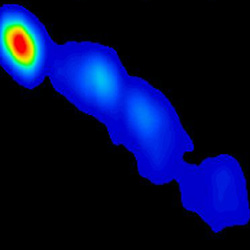
VLBA image of quasar 3C 273, with its long jet blasting out. Image credit: NRAO. Click to enlarge.
When a pair of researchers aimed the National Science Foundation’s Very Long Baseline Array (VLBA) radio telescope toward a famous quasar, they sought evidence to support a popular theory for why the superfast jets of particles streaming from quasars are confined to narrow streams. Instead, they got a surprise that “may send the theorists back to the drawing boards,” according to one of the astronomers.
“We did find the evidence we were looking for, but we also found an additional piece of evidence that seems to contradict it,” said Robert Zavala, an astronomer at the U.S. Naval Observatory’s Flagstaff, Arizona, station. Zavala and Greg Taylor, of the National Radio Astronomy Observatory and the Kavli Institute of Particle Astrophysics and Cosmology, presented their findings to the American Astronomical Society’s meeting in Minneapolis, Minnesota.
Quasars are generally thought to be supermassive black holes at the cores of galaxies, the black hole surrounded by a spinning disk of material being drawn inexorably into the black hole’s gravitational maw. Through processes still not well understood, powerful jets of particles are propelled outward at speeds nearly that of light. A popular theoretical model says that magnetic-field lines in the spinning disk are twisted tightly together and confine the fast-moving particles into narrow “jets” streaming from the poles of the disk.
In 1993, Stanford University and Kavli Institute astrophysicist Roger Blandford suggested that such a twisted magnetic field would produce a distinct pattern in the alignment, or polarization, of radio waves coming from the jets. Zavala and Taylor used the VLBA, capable of producing the most detailed images of any telescope in astronomy, to seek evidence of Blandford’s predicted pattern in a well-known quasar called 3C 273.
“We saw exactly what Blandford predicted, supporting the idea of a twisted magnetic field. However, we also saw another pattern that is not explained by such a field,” Zavala said.
In technical terms, the twisted magnetic field should cause a steady change, or gradient, in the amount by which the alignment (polarization) of the radio waves is rotated as one looks across the width of the jet. That gradient showed up in the VLBA observations. However, with a twisted magnetic field, the percentage of the waves that are similarly aligned, or polarized, should be at its greatest at the center of the jet and decrease steadily toward the edges. Instead, the observations showed the percentage of polarization increasing toward the edges.
That means, the astronomers say, there either is something wrong with the twisted-magnetic-field model or its effects are washed out by interactions between the jet and the interstellar medium that it is drilling through. “Either way, the theorists have to get to work to figure out how this can happen,” Zavala said.
When notified of the new results, Blandford said, “these observations are good enough to warrant further development of the theory.”
3C 273 is one of the most famous quasars in astronomy, and was the first to be recognized as a very distant object in 1963. Caltech astronomer Maarten Schmidt was working on a brief scientific article about 3C273 on the afternoon of February 5 that year when he suddenly recognized a pattern in the object’s visible-light spectrum that allowed an immediate calculation of its distance. He later wrote that “I was stunned by this development…” Just minutes later, he said, he met his colleague Jesse Greenstein, who was studying another quasar, in a hallway. In a matter of another few minutes, they found that the second one also was quite distant. 3C 273 is about two billion light-years from Earth in the constellation Virgo, and is visible in moderate-sized amateur telescopes.
The VLBA is a system of ten radio-telescope antennas, each with a dish 25 meters (82 feet) in diameter and weighing 240 tons. From Mauna Kea on the Big Island of Hawaii to St. Croix in the U.S. Virgin Islands, the VLBA spans more than 5,000 miles, providing astronomers with the sharpest vision of any telescope on Earth or in space. Dedicated in 1993, the VLBA has an ability to see fine detail equivalent to being able to stand in New York and read a newspaper in Los Angeles.
“The extremely sharp radio ‘vision’ of the VLBA was absolutely necessary to do this work,” Zavala explained. “We used the highest radio frequencies at which we could detect 3C273’s jet to maximize the detail we could get, and this effort paid off with great science,” he added.
The National Radio Astronomy Observatory is a facility of the National Science Foundation, operated under cooperative agreement by Associated Universities, Inc.
Original Source: NRAO News Release
